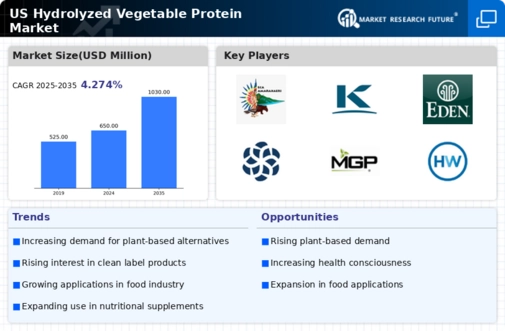Expansion of Food Applications
The versatility of hydrolyzed vegetable proteins is a key driver in the market, as they find applications across various food products. From snacks to beverages, the hydrolyzed vegetable-protein market is witnessing an increase in demand due to the incorporation of these proteins in diverse formulations. For instance, the use of hydrolyzed vegetable proteins in meat alternatives and dairy substitutes is becoming more prevalent, appealing to both vegetarians and flexitarians. This expansion into new food categories is expected to contribute to a compound annual growth rate (CAGR) of around 7% in the hydrolyzed vegetable-protein market over the next five years, indicating robust growth potential.
Increasing Health Consciousness
The hydrolyzed vegetable-protein market is experiencing growth driven by a rising awareness of health and wellness among consumers. As individuals increasingly seek nutritious food options, the demand for plant-based proteins has surged. This trend is reflected in the market, where the value of plant-based protein products is projected to reach approximately $10 billion by 2026. Consumers are gravitating towards hydrolyzed vegetable proteins due to their perceived health benefits, including improved digestion and enhanced nutrient absorption. The hydrolyzed vegetable-protein market is thus positioned to capitalize on this health-conscious shift, as more people incorporate these proteins into their diets to support overall well-being.
Innovations in Product Development
Innovation plays a crucial role in the hydrolyzed vegetable-protein market, as manufacturers continuously seek to enhance product quality and functionality. Advances in processing technologies are enabling the development of hydrolyzed vegetable proteins with improved solubility, taste, and texture. This focus on innovation is likely to attract a broader consumer base, including those who may have previously been hesitant to try plant-based proteins. The hydrolyzed vegetable-protein market is thus poised for growth, as companies invest in research and development to create novel products that meet evolving consumer preferences. The introduction of new formulations could potentially lead to a market expansion valued at over $5 billion by 2028.
Rising Vegan and Vegetarian Populations
The hydrolyzed vegetable-protein market is significantly influenced by the growing number of individuals adopting vegan and vegetarian lifestyles. As more consumers choose plant-based diets for ethical, environmental, or health reasons, the demand for hydrolyzed vegetable proteins is likely to increase. Recent surveys indicate that approximately 6% of the U.S. population identifies as vegan, a figure that has doubled in recent years. This demographic shift is prompting food manufacturers to innovate and expand their product lines, thereby enhancing the hydrolyzed vegetable-protein market. The increasing acceptance of plant-based diets suggests a sustained demand for hydrolyzed vegetable proteins in the foreseeable future.
Sustainability Trends in Food Production
Sustainability is becoming a pivotal factor influencing consumer choices, and the hydrolyzed vegetable-protein market is no exception. As environmental concerns rise, consumers are increasingly favoring products that are perceived as sustainable. Hydrolyzed vegetable proteins, derived from plant sources, align with this trend, as they typically have a lower carbon footprint compared to animal-based proteins. The hydrolyzed vegetable-protein market is likely to benefit from this shift, as brands that emphasize sustainable sourcing and production practices may attract environmentally conscious consumers. This growing emphasis on sustainability could lead to a notable increase in market share for hydrolyzed vegetable proteins, potentially reaching a valuation of $8 billion by 2030.

















Leave a Comment